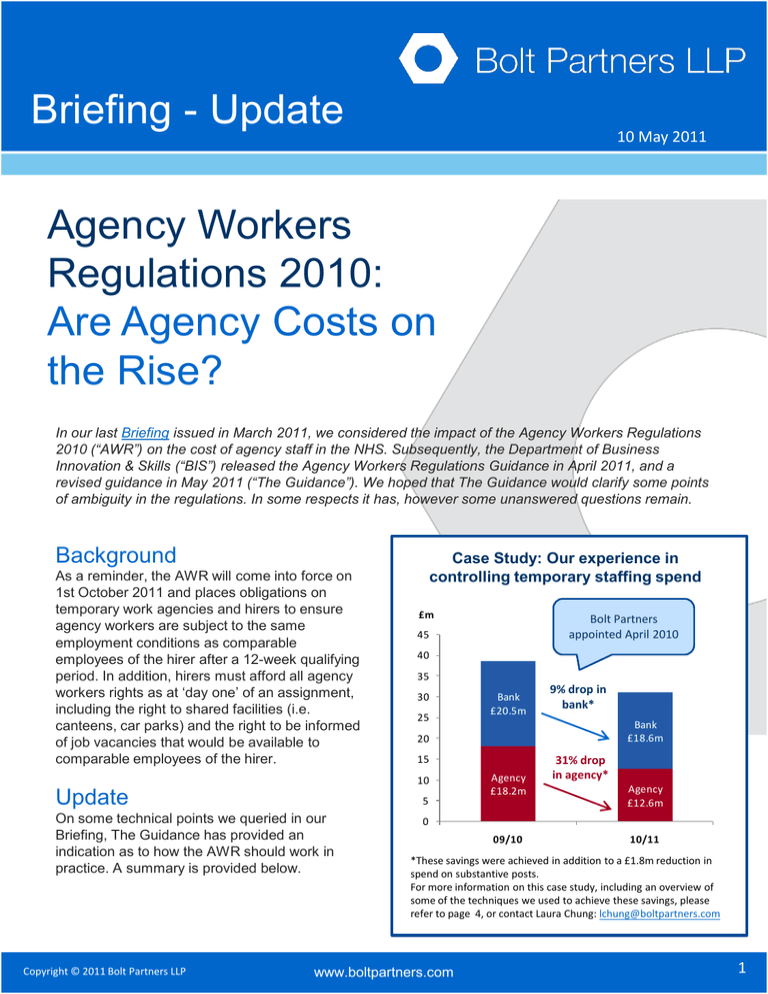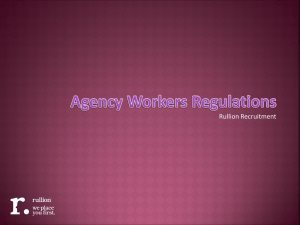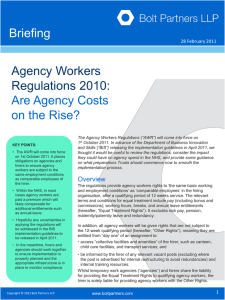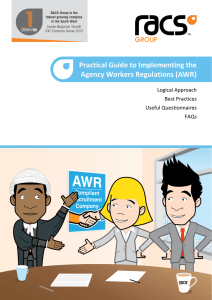Briefing - Update Agency Workers Regulations 2010: Are Agency
advertisement

Briefing - Update 10 May 2011 Agency Workers Regulations 2010: Are Agency Costs on the Rise? In our last Briefing issued in March 2011, we considered the impact of the Agency Workers Regulations 2010 (“AWR”) on the cost of agency staff in the NHS. Subsequently, the Department of Business Innovation & Skills (“BIS”) released the Agency Workers Regulations Guidance in April 2011, and a revised guidance in May 2011 (“The Guidance”). We hoped that The Guidance would clarify some points of ambiguity in the regulations. In some respects it has, however some unanswered questions remain. Background As a reminder, the AWR will come into force on 1st October 2011 and places obligations on temporary work agencies and hirers to ensure agency workers are subject to the same employment conditions as comparable employees of the hirer after a 12-week qualifying period. In addition, hirers must afford all agency workers rights as at ‘day one’ of an assignment, including the right to shared facilities (i.e. canteens, car parks) and the right to be informed of job vacancies that would be available to comparable employees of the hirer. Case experienceinin CaseStudy: Study:Our Our experience controlling temporary spend controlling temporarystaffing staffing spend £m 40 35 30 25 Copyright © 2011 Bolt Partners LLP 9% drop in bank* Bank £18.6m 15 5 On some technical points we queried in our Briefing, The Guidance has provided an indication as to how the AWR should work in practice. A summary is provided below. Bank £20.5m 20 10 Update Bolt Partners appointed April 2010 45 Agency £18.2m 31% drop in agency* Agency £12.6m 0 09/10 10/11 *These savings were achieved in addition to a £1.8m reduction in spend on substantive posts. For more information on this case study, including an overview of some of the techniques we used to achieve these savings, please refer to page 4, or contact Laura Chung: lchung@boltpartners.com www.boltpartners.com 1 Query Commentary • To establish whether the AWR will apply, there must be a tripartite relationship between an individual, an agency and a hirer. The definition of agency worker excludes those who are in “business on their own account” (a true business-to-business relationship), however it includes individuals working through an umbrella company Scope of “agency worker”: will it include contractors? • All agency workers that are employees of an agency are already entitled to the statutory minimum paid holiday of 28 days per year (including bank holidays) which is paid by the agency (and costs rolled up into the rates charged to the hirer). Contractors that are self employed are not currently entitled to any holiday pay from the agency, yet if the tripartite relationship is present, they may be considered “agency workers” in the AWR and be entitled to holiday pay • Under the AWR, qualifying agency workers are entitled to the leave entitlement that forms part of the “basic working and employment conditions” of comparable employees of the hirer (i.e. includes leave entitlements that are in excess of the statutory minimum). Where the cost of this entitlement is not already priced into the pay rate of the agency worker, we can expect to see a rise in the cost of agency workers What is the impact of salary banding and pay scales? To calculate annual leave entitlement: is the ‘comparable employee’ assumed to be in the first year of NHS service or do you take into account the agency worker’s continuous NHS service? The relevant pay rate is “the annual salary an agency worker would have received if recruited directly”. The hirer must conduct the assessment of the relevant pay grade the agency worker would fall into based upon comparable employees, having regard to the skill and experience of the agency worker, and provide this information to the agency for application • The annual leave entitlement for NHS workers is based upon years of NHS service, and follow the worker from Trust to Trust. The range is from 27 days to 33 days annual leave (plus 9 bank holidays in 2011 and 2012) [note this is up to 14 days more than the statutory minimum of 28 days (which includes bank holidays)] • The Guidance states that equal treatment is applied by providing “the treatment you would have given that person if recruiting them directly to that job...i.e. what pay and holidays would he/she be entitled to, given a particular role and his/her particular skill and qualifications” • Since the higher annual leave entitlement is based upon the individual’s years of service (rather than skills or qualifications), there remains some ambiguity as to what the relevant entitlement should be • However this may be an irrelevant distinction if the current rate of pay already covers the ‘payment in lieu’ of the higher leave entitlement, so an initial comparison of pay rates to the higher leave entitlement is advised Can workers accrue AWR rights for multiple hirers concurrently? Yes. The Guidance states that agency workers can have qualifying periods running at different hirers at the same time. For large organisations, such as the NHS, the worker will have to complete the qualifying period at each hiring entity (i.e. each Trust) whereas Supply Teachers (for community schools) are employed by the Local Authority (“LA”) and any work conducted for that LA (even if at different schools) will count towards the qualification period. Does the qualifying period accumulate if booked through different agencies for the same hirer? Yes. The Guidance suggests that agencies request a full work history from the agency worker so that they can properly monitor the qualifying period. In this respect, the AWR places some of the responsibility on the agency worker to co-operate, and any failure of the agency worker to provide work history information will be taken into account in assessing an agency and/or hirer’s liability for a breach of the AWR. Copyright © 2011 Bolt Partners LLP www.boltpartners.com 2 Implementation The practical implementation considerations for hirers that we iterated in our initial Briefing remain the same: What can hirers do now to prepare? 1. Conduct high level reviews of agency workers’ current pay and conditions versus comparable employees, and consider the duration of agency workers’ assignments to estimate the cost implications for the organisation of implementing the AWR 2. For NHS hirers, increase bank resources by incentivising staff to work on the Trust bank rather than do agency shifts elsewhere 3. Revise policies, procedures and systems to ensure that by 1st October 2011, all agency workers have access to collective facilities (e.g. canteen, childcare, transport) and are informed about permanent employment opportunities and internal training resources as a matter of course 4. Prepare information packs to provide to agencies that set out the working and employment conditions of employed staff for roles that agency workers may fill 5. Review information systems and conduct spot checks to see whether existing systems can accurately track an agency worker’s service in the hirer’s organisation 6. Set up discussions with agency suppliers to agree an implementation timetable Conclusion As a significant employer of agency workers, NHS organisations can expect that implementing the AWR will have a cost impact: At a minimum, the costs will be internal and will relate to collating and disseminating information, and conducting assessments of posts and agency workers to determine relevant comparable employment and working conditions; Higher external costs can be expected if the existing pay rates of agency workers do not accommodate holiday pay (or agencies choose to pass through their administration costs) which results in increased rates for agency staff. Costs of implementation can be minimised by ensuring organisations have standard information/induction packs, templates are prepared to respond to agency or agency worker queries, and processes are set up to standardise the analysis of agency workers to comparable employees. Whilst our Briefings have provided an overview of some of the issues involved, it is recommended that organisations read both the AWR and The Guidance documents to provide a complete picture of the relevant rights and obligations in the legislation. References • The Agency Workers Regulations 2010 • Agency Workers Regulations Guidance, Department for Business Innovation & Skills (April 2011) (reissued May 2011) Emily Montgomery emontgomery@boltpartners.com Copyright © 2011 Bolt Partners LLP www.boltpartners.com Laura Chung lchung@boltpartners.com 3 About Us Bolt Partners LLP is a leading turnaround and performance consulting boutique specialising in healthcare, consumer goods and services, and professional and industrial services. We work with organisations in distressed situations, either as interim executive management (Chief Executive Officer, Chief Financial Officer, Chief Restructuring Officer) or on an advisory basis. Temporary Staffing Controls is an area we specialise in and have proven success in the delivery of significant savings within healthcare organisations and other staff intensive businesses in the United Kingdom. A sample of our credentials is provided below. Case Study 1, 2006 Case Study 2, 2010-11 Background: Background: • The Trust was facing annual temporary staffing spend in nursing of £12m and 300 WTE per annum immediately prior to our engagement • Prior to our involvement, temporary staffing spend was out of control, escalating to c.£40m in FY09/10 • • Controls and processes were weak with ownership and accountability lacking With 3 separate bank offices, controls were limited on all aspects of temporary staffing, from authorisation stage through to invoice payments Actions: Appointed January 2006 Actions: Appointed April 2010 • Consolidated the ordering of temporary staff and introduced robust controls resulting in reduction in usage by 100 WTE • Merger of bank offices across 3 sites to centralise internal and external bookings • • Weekly review of spend and usage with firm challenges of expenditure at ward level Introduced weekly reporting and subsequent challenge • • Developed in-house training and toolkit; encouraged planning and sharing of resources across Divisions Increased authorisation levels for all bookings. More stringent controls over long term bookings and additional sessions • Supplier rationalisation and renegotiation • • Implemented robust checks and balances on invoices to ensure compliance with new controls Ban on agency usage within certain staff groups and elimination of usage of non PASA agencies, use only by exception • Renegotiation with preferred suppliers on rates and worked closer with agencies to ensure compliance with new procedures • Greater scrutiny of invoices prior to payment Results: • £5.0m reduction in nursing agency, from £12m to £7m and 100 WTE reduction (delivered recurrent FYE) • Reduced vacancy rate • Decline in reported clinical incidents Results: • £7.5m reduction in bank and agency, from £38.7m in FY09/10 to £31.2m in FY10/11 • Additional saving of £1.8m in substantive posts in FY11/12 (Total annual pay related savings of £9.3m) • Consolidated invoicing on preferred suppliers to one weekly invoice, saving £7 per invoice Contact For more information please contact Laura Chung, lchung@boltpartners.com or Emily Montgomery, emontgomery@boltpartners.com Copyright © 2011 Bolt Partners LLP www.boltpartners.com 4






